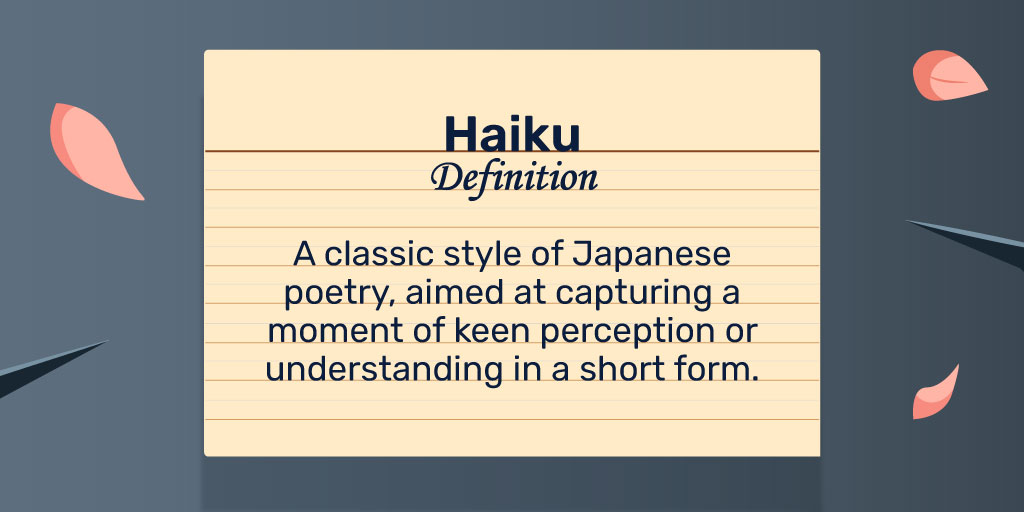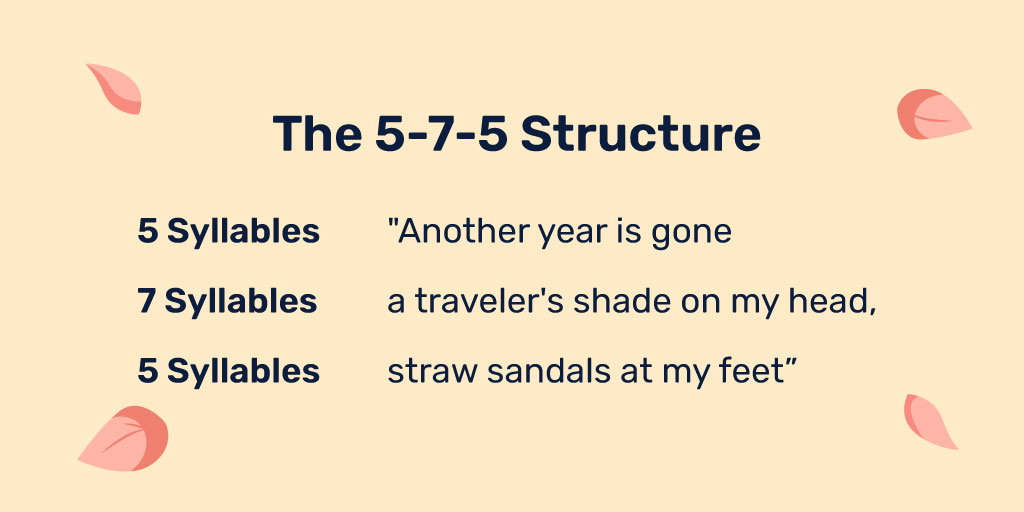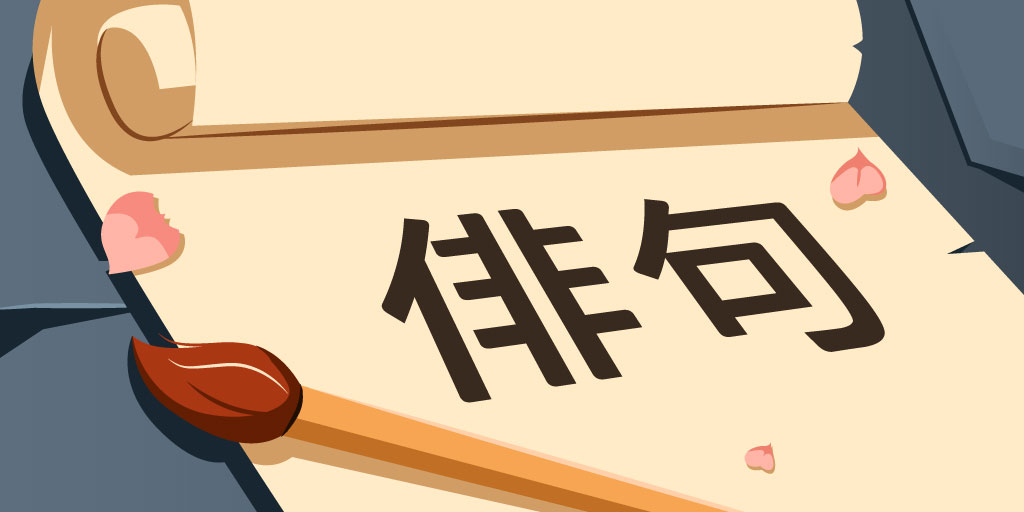It’s easy to be mesmerized by the beauty and simplicity of a haiku, to marvel at the way just a few words can capture the essence of a moment or convey a powerful emotion. Despite its brevity, a haiku has the ability to transport readers to another time and place, evoking a range of feelings and leaving a lasting impression.
In what follows, we’ll delve into the rich history and traditions of this Japanese poetic form and unlock the secrets to crafting a haiku.
What is a Haiku Poem?
A haiku poem is a form of Japanese poetry that consists of three non-rhyming lines with 17 syllables. The first and third lines contain five syllables, while the second line contains seven.
The purpose of a haiku is to record a moment of keen insight or awareness, frequently in relation to nature or the ebb and flow of the seasons. They are designed to evoke feelings of awe, wonder, and beauty, leaving the reader with a deeper appreciation for their surroundings.

Because of the poem’s conciseness and simplicity, readers are encouraged to take their time and appreciate each word. This enables them to completely engage with its imagery and emotions. Haiku often use natural imagery to convey deeper truths or abstract themes, like the transience of life, the interconnectedness of all things, or the beauty of simplicity.
Haiku originated in Japan in the 17th century and was inspired by Zen Buddhist principles. Poets like Matsuo Basho, who is frequently regarded as the greatest haiku poet of all time, helped to popularize the genre.
With the act of writing or reading a haiku functioning as a form of awareness and introspection, it can be used for meditation. The process encourages writers to pay closer attention to the world around them and to condense their thoughts into a few thoughtfully chosen words. As such, it can help us develop a sense of presence and appreciation for the current moment.
Craft of Writing Quiz (Easy)

Characteristics and Structure of Haiku Poetry
To truly appreciate the beauty and power of haiku poetry, it is important to understand its defining characteristics. Below, we’ll explore the key elements of the traditional form, from its structure and syllable count to its use of natural imagery and cutting words.
If you want to write your own haiku, you should also pay attention to the differences between the traditional form and its modern variations that we describe below.
Syllable Pattern
According to Japanese tradition, a haiku is composed of 17 on, a word that loosely translates to syllable. Many purists, however, contend that the translation of on to syllable is not precise, and that 17 on actually translates to 12 units of pronunciation. But despite this argument, the 17 has stuck and it is customary to write it in English with 17 syllables.
Additionally, Japanese poets wrote their haiku in a single line, while English poets have typically arranged them into three lines with a syllable pattern of 5-7-5.

Since artists have the delightful habit of breaking rules in the process of crafting their creative masterpieces, however, many contemporary haiku poets often use fewer syllables than the traditional 17. This practice emerged partly from the understanding that 17 on is shorter than 17 syllables, and from the reality that many traditional Japanese haiku have been perfectly translated with fewer than 17.
Look at this perfect translation of a change-of-seasons haiku by Matsuo Basho:
“In the cicada’s cry
No sign can foretell
How soon it must die.”
It is recognizably a haiku, even though it does not adhere to the 5-7-5 syllable count. Any additional syllables would’ve been superfluous.
If writers stick to the philosophy of haiku by ensuring that it is speakable in a single breath, then their poem can qualify as a haiku.
Cutting Word
Haiku poems usually include a cutting word, known as a kireji, to separate the poem into two distinct parts or to indicate a break in rhythm. This is a grammatical category of words that create a pause or sense of closure, for which there is no direct equivalence in English.
English authors sometimes use punctuation to fulfill this role, but if the poem cannot be neatly divided, they simply omit it.
Consider this poem by the musician and poet Johnette Downing:
“The empty closet,
Unscented clothes, cold hangers—
A widow’s morning.”
The first section includes three closely related ideas that are separated by commas. A hyphen then indicates that the second section has arrived in which that rhythm is broken. Now there are no more ideas or imagery, but instead a simple summary of what the imagery means. That hyphen plays the role of the kireji.
Season Word
Traditional haiku contains a kigo, a word or phrase that signals a season and its accompanying mood, such as samushi (cold) for winter, sakura (cherry blossoms) for spring, semi (cicadas) for summer, and momiji (red leaves) for autumn.

Contemporary English haiku that are focused on the seasons can easily include such words, as in blossom for spring and sunburn for summer. But they are not required in poems that involve different issues or themes.
However, the point of a kigo is to keep the poem as concise as possible, so even poems that don’t involve seasons include some version of it.
This gloomy little haiku by Matsuo Basho does it well:
“Autumn moonlight—
a worm digs silently
into the chestnut.”
The worm digging into the chestnut is a metaphor for the impermanence of life and the inevitability of decay, and the phrase “Autumn moonlight” is a short phrase that stands for someone or something that is heading towards the end of life.
Natural Focus
The classic form focuses on nature, seasonal changes, or other elements of the natural world, which it inherited from a long Japanese tradition of poetry that emphasizes the beauty of the environment.
But modern poets have shown that it is adaptable to a wide range of subjects and themes that are relevant to our lives in the 21st century.
Have a look at this one by an American poet called Alexis Rotella:
“The city lights blur
Into a neon river
Of flickering dreams.”
This poem addresses the common belief that the city can be a place of endless possibility and potential, while also acknowledging the overwhelming and sometimes dizzying experience of navigating its crowds. As such, it deals with themes that would have been of limited use in the 17th century, but that are very relevant today.
Universal Themes
A traditional haiku uses natural imagery to convey universal themes like the passage of time and the contrast between light and dark. This has not changed much in its contemporary form.
Modern Japanese poet Kyoshi Takahama, for example, formulated this treasure about the fleeting nature of life:
“A gust of wind—
Cherry blossoms scatter and
Recollect my past.”
This focus on universal themes contrasts with longer forms of poetry that often deal with personal experiences like love or loss.
Single Moment or Thought
Because it is so concise, a haiku contains one single theme, moment, emotion, or observation, while longer poetry can explore multiple perceptions in a single poem.
With its laser focus on one theme or emotion, a haiku allows the reader to fully immerse themselves in the imagery or emotion of the poem, without being distracted by the extended metaphors or complex imagery included in longer poetry.
In “Sonnet 18,” for example, William Shakespeare uses a series of metaphors and comparisons to express his love for a young man: It starts with “Shall I compare thee to a summer’s day,” and then tours through the differences and similarities between the beloved and the summer’s day.
A haiku would have taken only one resemblance or dissimilarity and contemplated just that in all its beauty.
Juxtaposed Images
Haiku often use juxtaposed images to create a sense of contrast or surprise, heightening the emotional impact of the poem. These are images placed together in a way that creates a striking comparison or contrast.
By using two seemingly unrelated pictures, poets can create a sense of tension or surprise, inviting the reader to make unexpected connections and associations.
This is not required, but it can make a poem stand out, as in this gem by Yosa Buson:
“Clinging moon,
a tree stands alone
in the autumn breeze.”
The juxtaposed images of the clinging moon and the solitary tree create a sense of contrast, inviting the reader to reflect on the interconnectedness of all things, even in moments of apparent separation.
Examples of Haiku Poems
In addition to the illustrative haiku in the sections above, let’s examine classic poems by the four greatest writers that are often credited with establishing and popularizing this poetic form. In Japan, they are known as the four haiku masters.
“The Old Pond” by Matsuo Basho
One famous haiku poem is “The Old Pond” by Matsuo Basho, a Japanese poet who lived in the 17th century. Here is the poem:
“An old silent pond …
A frog jumps into the pond,
splash! Silence again.”
This haiku is a classic example of the form. It captures a moment of stillness and surprise. The old pond, a symbol of stillness and timelessness, is suddenly disrupted by the frog’s leap, reminding us of the constant flux and change that characterizes the natural world.
Matsuo Basho was born in Japan in 1644 and lived during the Edo period, a time of cultural and artistic flourishing in Japan. Over the course of his life, he wrote hundreds of haiku poems and his name is synonymous with this art form.
“Blown from the West” by Yosa Buson
The Japanese poet Yosa Buson wrote this little gem:
“Blown from the west,
fallen leaves gather
in the east.”
In part, it reflects on the impermanence of life. The leaves, once part of a living tree, have fallen to the ground and are now at the mercy of the wind, being blown in whatever direction it takes them. The image of the leaves gathering in the east suggests a kind of final resting place, but also reminds us of the cyclical nature of life, with each ending leading to a new beginning.
Yosa Buson was born in 1716 and was a prominent Japanese poet and painter of the Edo period. He was a student of both haiku and Chinese poetry, and his work reflects the influence of both traditions. His work as a painter also helped him to create spectacular visual imagery in his poems.
“In This World” by Kobayashi Issa
This is a poem about one of the great paradoxes of life:
“In this world
we walk on the roof of hell
gazing at flowers.”
This poem reflects on the fact that the world can be a place of great suffering and hardship, yet at the same time, it is filled with beauty and wonder. The image of walking on the roof of hell suggests that we are always at the brink of suffering, yet the flowers that we gaze at represent the moments of beauty and joy that can be found even in the midst of adversity.
Born in 1763, Kobayashi Issa knew all about suffering. He lost his mother at the age of three, was treated harshly by his stepmother during his childhood, and had to bury three of his children.
“Asleep in a Boat” by Masaoka Shiki
This poem captures a lovely experience in nature:
“Asleep in a boat
I lie side by side with it:
the River of Heaven.”
While lying asleep in a boat, Shiki is lying side by side with the river, which can be seen as a symbol of the flow of life. The River of Heaven may also be a reference to the Milky Way, which was often associated with spiritual themes in Japanese culture.
Masaoka Shiki lived in the 19th century and revived short poetry forms like haiku during a period when they were becoming unpopular. He suffered from tuberculosis for most of his life and died at age 34.
How to Write a Haiku Poem
If you’ve ever wanted to try your hand at writing haiku, but weren’t sure where to start, this section will take you through the step-by-step process of writing one, from choosing a subject to refining your words for maximum impact.

1. Read Classic Haiku
Reading the classics serves many purposes. It will help you to know what a haiku is supposed to look and sound like when read aloud. You can also find ideas of what to think and write about.
Haiku anthology books are good places to start, as they contain poems by various authors in single collections.
These are three popular and widely available options:
- The Essential Haiku: Versions of Basho, Buson, and Issa by Robert Hass.
- Basho: The Complete Haiku translated by Jane Reichhold.
- The Classic Tradition of Haiku: An Anthology by Faubion Bowers.
2. Learn the Rules
In the previous section of this guide, you will find plenty of characteristics and structural elements of the classic and modern haiku. Familiarize yourself with the conventions of this poetry as well as the ways in which they have been adjusted.
To recap:
- Stick as close as possible to 17 syllables, written across three lines with a 5-7-5 pattern.
- Use punctuation if your haiku requires a pause or break in rhythm.
- Include words or phrases that symbolize bigger concepts, such as “autumn moonlight” for old age.
- Keep to universal themes rather than personal feelings.
- Focus on one single thought.
- Create juxtaposed images for contrast or surprise.
3. Choose a Subject
When choosing a subject for a haiku, it’s often best to start with something that inspires you or captures your attention. Many haiku poets focus on nature, but you can choose any topic that sparks your imagination and evokes a sense of beauty or fascination.
Take a walk in the park, visit the beach, or simply sit outside and observe the world around you.
Think about events from your own life or the lives of others that are particularly meaningful or memorable, such as moments of joy or sadness.
Ask new questions about the things you see every day. What do they mean? What are their implications? What emotions do they evoke?
4. Hone Your Sensory Imagery
Once you have picked a subject or theme, think of specific sensory details, such as the sound of a bird’s song or the texture of a tree’s bark, to create a vivid image in your reader’s mind.
Think of the whispering choir of leaves, the honking of horns, the hum of computers, a sweet fragrance, the velvety softness, and the like.
5. Pick a Broad Theme
While poems that do no more than describe nature can be beautiful, try to find a broader meaning behind the image you are portraying. A butterfly emerging from its chrysalis signifies transformation and rebirth. A winding road disappearing into the horizon represents a scary journey. A flickering candle flame signals the fragility of life.
6. Write the First Draft
With your general idea, your imagery, and your broad theme in mind, now it is time to start writing. It is not particularly important to count syllables at this stage. Just write a sentence that captures what you want to say.
Play with different words, word combinations, and punctuation. Try to identify some short phrases that evoke strong images. This is also the stage where you can start thinking of cutting and season words and whether they will fit your poem.
7. Craft Your Poem
Now, select the best words and phrases from the ones you wrote down and compile your haiku. If it is more than 17 syllables, revise your choice of words to shorten it. If it contains fewer than 17 syllables, it is not a major problem, so long as the idea can be arranged over three lines.
Insert the punctuation that separates images from each other and that breaks up the poem, if needed.
8. Edit and Refine
Take a break from the haiku you just wrote. When you return, read it aloud to yourself to check whether it flows and whether it has a pleasant rhythm. If some words are too long or short, browse a thesaurus to find alternatives.
If you have a friend or relative that reads poetry, run it by them and ask for their honest opinion. In particular, ask them whether your images and themes are fresh enough not to appear clichéd.
9. Publish Your Haiku
The best approach to have a haiku published is to submit them to journals and magazines that regularly print them. The advantages are that an editor will look at your submissions and that someone else is responsible for the printing and formatting. The main drawback is that you will have to observe their writing guidelines very carefully for your efforts to be accepted.
Some potential publishers are Haikuniverse, Haiku Journal, Modern Haiku, Haiku Commentary, and Frogpond.
Frequently Asked Questions
In this section, we’ll answer some common questions about haiku, from its origins and structure to its themes and styles.
What Are the Rules for a Haiku?
The traditional rules for a haiku include a three-line structure with a 5-7-5 syllable count and a focus on nature or seasonal imagery. It is also meant to include the use of a kigo or season word that signifies a time of year, and the service of a cutting word or kireji that indicates a pause or break in rhythm.
However, modern haiku often diverge from these rules to varying degrees, prioritizing brevity, sensory imagery, and evocative themes over strict adherence to syllable count or natural subject matter.
Can a Haiku Be Written About Anything?
While the traditional focus of haiku is on nature or seasonal imagery, modern haiku can be written about anything. As long as the poem captures a moment of intense awareness or understanding and uses sensory imagery to convey a deeper truth or theme, it is a haiku.
Does a Haiku Always Have 17 Syllables?
No, a haiku does not always have 17 syllables. Many classic Japanese haiku could never be translated into English with 17 syllables, which gave rise to an English haiku convention that deemed as acceptable anything between 12 and 17 syllables.
Which Line is the Longest in a Haiku?
In traditional haiku, the longest line is the second line, which contains seven syllables. However, modern haiku often diverge from this convention, and the longest line can vary depending on the individual poem. Ultimately, the length of each line should serve the overall structure and impact.
Can a Haiku Consist of Two Sentences?
Yes, a haiku can consist of two sentences. In fact, since English authors often use punctuation like an exclamation point where Japanese authors place a cutting word or kireji, many English poems consist of two sentences.
Do Haiku Have Punctuation?
Traditional haiku typically do not have punctuation, as the poem’s structure and word choice are meant to convey everything. However, modern haiku may include some punctuation to add clarity or emphasis to the poem, usually in the form of commas, exclamations, dashes, and ellipses.
Do Haiku Have to Rhyme?
No, they do not have to rhyme. In fact, traditional Japanese haiku do not use rhymes at all. While some modern haiku poets may choose to use rhyme in their poetry, it is not a necessary element of the form.
Can You Repeat a Word in a Haiku?
It is possible to repeat a word in a haiku, but it is generally not recommended. Haiku are meant to be concise and focused on a specific moment or theme, so repeating a word can be seen as detracting from that focus. However, if the repetition serves a specific purpose in the poem, such as emphasizing a particular sound or image, it can be effective.
Can a Haiku Contain a Question?
A haiku can contain a question, but it is not typical. Haiku are usually meant to be a statement or observation, capturing a moment of perception or insight. However, if a question serves to emphasize the theme or moment being captured, it can be used effectively.
Are There Other Haiku Structures?
There are other haiku structures that have been developed over time, such as a two-line haiku with the first containing five and the second twelve syllables. A one-line haiku is also sometimes seen with fewer than 17 syllables.
Does a Haiku Have a Title?
Haiku typically do not have titles. Instead, they are identified by their first line, which serves to establish the setting or theme of the poem. The lack of a title allows the focus to remain on the sensory imagery and theme being conveyed.
How Do You Format a Haiku?
Traditionally, a haiku is formatted as a three-line poem with a specific syllable count for each line. The first line contains five, the second line seven, and the third line five, for a total of 17 syllables.
Final Thoughts
Haiku poetry continues to be a beloved and revered form of poetry due to its ability to convey powerful emotions, moments of insight, and universal themes in a concise and vivid way. Whether used as a tool for mindfulness and reflection, or simply as a means of creative expression, it has proven to be a valuable and timeless art form that continues to inspire and captivate readers and writers around the world.
Craft of Writing Quiz (Hard)








